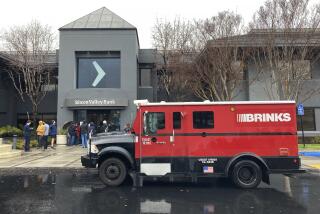Next L.A. / A look at issues, people and ideas helping to shape the emerging metroplis : Airport Funds Study of Fighting Noise With Noise
It could be the perfect idea for quieting the roaring sound of airplanes departing from the Burbank airport. Or simply wishful science fiction technology.
Hoping to find out, airport officials have allocated $550,000 for UCLA researchers to study fighting jet noise with more noise.
Hypothetically, loudspeakers equipped with computer chips would generate a counter-blast of sound to dampen the high-decibel scream of an airplane passing over.
It could work this way. Sensors outside a home would detect the whine of a jet climbing out at Burbank. The acoustic profile of the sound would be transmitted to a computer at the airport. The computer would return the opposite frequencies for broadcast over the loudspeakers.
Although the concepts of “active noise control” and “noise cancellation” are widely used in headphones worn by pilots, they are virtually untested in a large residential setting and are at least several years away from use.
But if the experiment works, it could turn out to be the perfect panacea for residents of the east San Fernando Valley who complain loudly and frequently about noise from Burbank airport.
Among the doubters are some Burbank City Council members and the airport’s nine-member operating board, the Burbank-Glendale-Pasadena Airport Authority, which has discussed spending as much as $2.1 million over four years on the idea.
“Putting all that money on one bet just doesn’t seem wise,” said Airport Commissioner Margie A. Gee. “The fact that it hasn’t been developed by anyone else has put further suspicion on it.”
Skeptics would prefer to see noise-reduction devices placed on the tail end of airplanes, like mufflers on cars. But engineering professor Chih-Ming Ho, who heads UCLA’s research team, says blasts of sound coming from an engine would be too powerful for any equipment to muffle.
Perhaps the most challenging aspect of the proposed technology, Ho said, is finding a way to drown out aircraft noise without reducing the audibility of sounds from other sources, such as televisions.
Others wonder how such a futuristic device (estimated to cost $5,000 for each home) could possibly cover a large outdoor space such as a front lawn. The equipment’s ability to cancel out the offending sound waves is complicated by any movement.
“The minute you move your head an inch or two, you lose the cancellation because the time of arrival to your ears has changed,” said Robert Mantell, a Hollywood-based manufacturer of telecommunications equipment.
“Trying to cancel the noise at some distance is physically impossible because of the laws of physics.”
More to Read
Start your day right
Sign up for Essential California for news, features and recommendations from the L.A. Times and beyond in your inbox six days a week.
You may occasionally receive promotional content from the Los Angeles Times.






